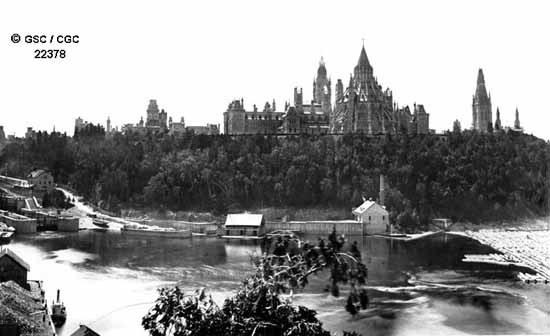

The stone foundation of the building with the tall smoke stack shown in the photograph above is still there to be admired along the bike path below Parliament Hill. The building was actually a Canadian classic and many views of the Parliament buildings from Major's Hill park or from Hull show the mill in association with the Library of Parliament. There is a picture of it on the back of the four dollar bill of 1900. "Picturesque Canada", a book of engravings from 1882, includes a wonderful view of this mill. This ashlar foundation dates back to the 1870's during the great boom of the Ottawa lumber operations.
It may seem odd that permission would be granted to build a steam mill below Parliament Hill where, just a few years earlier, the greatest neo-gothic monument in North America, the Canadian House of Parliament was built. A smokey vulgar steam-powered lumber mill, noisily sawing wood and spewing sawdust was set right below our national parliament! The first Prime Minister Sir John A. MacDonald held that there should always be industry within view of Parliament Hill to reinforce the impression of the hard-working nature of Canadians. Was this symbolic consideration the basis for the permission given by the planners of the national capital to build the mill?
The earliest representation of the mill that I can find is on the "Bird's Eye View of the City of Ottawa" drawn by Herm. Brosius and published in 1876. In that year the lumber industry in Ottawa was in the midst of a depression so it is more likely the mill was built a few years before that. The mill is not shown on any of the river views drawn in the 1860's. In 1871 in Ottawa there were approximately 1,200 saws producing 250 million board feet of lumber annually and therefore, that year seems the most reasonable time to suppose it was constructed. When was it taken down? It is shown on a map of Ottawa of 1918 in the Ottawa room of the public library. It is definitely missing from a certain 1932 watercolour of the back of Parliament. I have not seen it in any photographs from after 1916 with the new Parliament buildings. Was it a casualty of the municipal beautification exercises which took place between the wars?
The mill was about 40 feet wide and 60 feet deep with a smoke stack that towered about 60 feet above river level. Photographs show the top half of the stack was lighter in colour than the bottom half. The steam boiler was certainly fueled by cuttings and wood waste from the industry. It was one of many steam mills in the Ottawa area. The first steam-powered sawmill in the Ottawa area was owned by J.C.Blasdell in 1849 on the Ottawa River near Rockcliffe. Andrew Leamy built a second at Leamy Lake in 1853. In 1868 there was a steam mill built on the Hull shore opposite the Parliament buildings for the Wright & Batson Co.
A more detailed photo shows a stacking yard to the right of the building defined by a curious polygonal pier at the extreme right corner and a triangular work area defined by booms floating on the river. There were two piles of something in this stacking area and there is some evidence that logs were pulled to the right side of the building for processing inside.
Half way between the mill and the locks is a wood frame utility building with five riverside windows floating freely on the river. If one carefully compares the position of this utility building with the eastern end of the Parliament building above, it will be seen to be in two quite different relative positions on the two different photographs available. The building would just float up or down during the spring flooding and always stay at river log level.
Leading to the mill on the left is a tall wharf. Pictures from the 1850's show there was little building land at the base of the cliffs. The wharf would have to be high to access the building when the river flooded in the spring. In no photograph can I see obvious piles of stacked finished wood around the building. There is actually not much room to stack up anything anywhere. It would not surprise me to learn that the building was not a mill at all but rather served as a smithy servicing the steamboat trade or was involved somehow in assembling the lumber rafts often seen anchored in the river outside of it. There is another careful sketch of the scene and it shows a shed on the wharf between the utility building and our mill. Other pictures will occasionally show a steamboat tied up to the wharf on the left of the utility building.
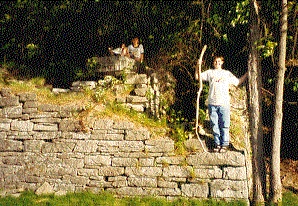
The site is very accessible and has much to interest a visitor. In the picture above my son David in the middle is sitting on a single stone block that is about 70 inches long, three feet wide and 14 inches thick. There is a subsurface passageway with well-made arches that might be part of the steam boiler system. This passageway is now filled in with leaves and dirt.
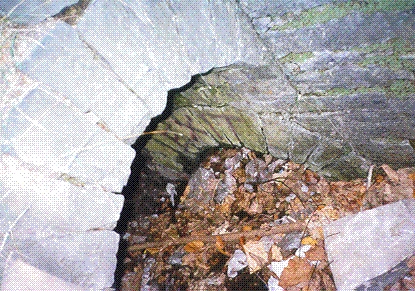
The stone base of the smokestack is still there to be inspected. The outside square stone walls are a couple of feet thick and thinner internal walls suggest how the working part of the mill was divided. Two predominant steel bars sticking out from the front wall are visible from the bike path.
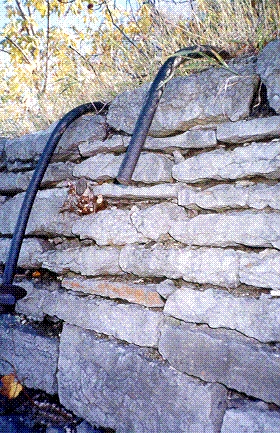
Suppose the NCC decided to do an industrial archaeological survey of the site and dig it up - what would likely be found? Recent litter, sawdust and wood scraps, water or steam pipes. The subterranean arches have been used as an unofficial privy for years so the digging job would not be much fun. Perhaps it would be better just to leave it the way it is.
The establishment which built the mill has long been forgotten and the local histories make no mention of the site. Officially it is either not known or benignly neglected. The site is now sometimes used as an ad-hoc camping area complete with a rotten mattress and an abandoned sleeping bag. The firepit shows that the itinerants had a fire to keep their outsides warm and broken glass from wine bottles show they had wine to keep their insides warm.
Here is final postcard image of the mill. This would be the impressive view that a visitor would see from a train crossing the Royal Alexandra Bridge coming into Union Station at the end of the 19th century.
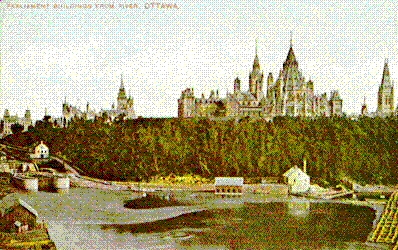
Literature Consulted
The first photo above, No. 22378 The Parliament Buildings, Ottawa, Ontario as seen from Nepean Point was taken by Robert Bell, head of the Geological Survey of Canada, in 1884. I found it on-line at http://www.nrcan.gc.ca/ess/esic/photojpeg/22378.jpg. The Herm. Brosius "Bird's Eye View of the City of Ottawa" of 1876, the poorly executed engraving of Barrack's Hill in The Illustrated London News - April 25 1857, the Rideau locks in W.S.Hunter Jr. "Ottawa Scenery" of 1855, and the Picturesque Canada engraving may be found on pages 39, 26, 86 and 118 respectively of Ottawa, A Pictorial Record by Charles P. deVolpi. The "Bird's Eye View" identifies many other mills illustrated by the picture but not the one I write about here. The Ottawa Room of the Public Library has insurance maps from long ago Ottawa but these exclude for some reason the Parliament Hill area and this mill. Look at page 24 of Hurling down the Pine by John W. Hughson and Courtney C.J. Bond for a photograph with clear details of the intriguing stacking yard on the west side of the mill as well as for the best history of steam and watermills in the district. The National Archives of Canada photograph PA-12382 by William James Topley shows the mill as well as the boat dock below Nepean Point. The Charlton Standard Catalogue of Canadian Government Paper Money 4th edition has the 1900/1902 $4 bill on page 116. The postcard is from the Postcards of Ottawa book. The pictures of the mill shown with Parliamentary Library are quite common. Les Bienheureux Martyrs de la Compagnie de Jésus au Canada by The Révérend Père Frédéric Rouvier, S.J. (1925 Montreal) has a well-done sketch on page 42.
The only evidence I have found that the mill might have been built earlier than 1870 is a poorly executed engraving of Barrack's Hill in The Illustrated London News - April 25, 1857 drawn by a certain Mr. Henderson, entitled "Ottawa, the Proposed New Seat of the Canadian Government". This drawing shows the majestic escarpment of Parliament Hill but with a strange new profile. The bluff is drawn as having a step half-way up and on this step is a building which, within the limits of the poor draftsmanship of the artist, might be considered to represent our mill. But I am not inclined to accept this as a witness with this early date. There is a much more careful drawing of the Rideau locks in W.S.Hunter Jr. "Ottawa Scenery" which was published in 1855. While this picture does not extend over far enough west to decide if our building proper is there or not, it does show that neither the companion building nor the wharf of our mill were built at that time.
